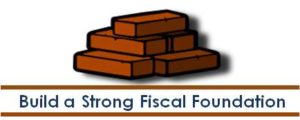As with physical, mental, and spiritual fitness, achieving fiscal fitness pays tremendous dividends. The essential elements of a sound fiscal foundation? Maintain a spending plan, minimize debt, establish an emergency fund, and contribute to retirement plans.
Maintaining a spending plan means itemizing current expenses. Doing so allows you to carefully track how much money you are taking in during a given period and figure out the best way to divide it among various categories. Moreover, a spending plan provides an opportunity to see where changes can be made with regards to expenses. A reduction in expenses means an opportunity to increase savings and investment contributions.
The second element is to minimize and manage debt. While some debt (e.g. college and car loans) is impossible to avoid for most, it can be minimized by limiting the number of outstanding loans as much as possible and by seeking the lowest interest rates possible when a loan is required.
The most significant ways to manage debt are to pay off loans as quickly as possible, limiting the amount paid in interest and to avoid carrying balances on credit cards. The interest paid on credit cards is an inhibitor to maintaining fiscal fitness and building wealth. Establishing an emergency fund, the third element, is the key to avoiding carrying credit card balances and dipping into monies intended for savings and investments.
An emergency fund is a cash account that is used only to fill critical financial gaps or meet unexpected expenses. With regard to the question of how much should be maintained in an emergency fund, there are various schools of thought. Some suggest living expenses for a given period (e.g. one year), while others suggest income for a given period (e.g. three or six months). In most cases, marital status (theoretically single people should have more as they are reliant on a single income); the number of children in the household, and the level of job security are the primary factors for consideration. Ultimately, the amount will vary for everyone as the factors that impact lives will be different. However, three months living expenses should be considered the minimum.
 The final element is to contribute to retirement plans. Most people will not have the benefit of a defined benefit plan; instead, they will be reliant on a defined contribution plan and an individual retirement savings plan to secure their financial future.
The final element is to contribute to retirement plans. Most people will not have the benefit of a defined benefit plan; instead, they will be reliant on a defined contribution plan and an individual retirement savings plan to secure their financial future.
With defined contribution plans, the employee and/or the employer contribute money to the employee’s account. The traditional 401(k) is the most popular type of defined contribution plan. In 2015 the contribution limit will increase from $17,500 to $18,000. Those individuals 50 (or turning 50 at any point during the year) or over will be allowed to add an additional $6,000 in “catch-up contributions” in the new year.
There are two major types of individual retirement savings plans, the traditional Individual Retirement Account (IRA) and the Roth IRA. In 2015, the limit for both will remain at $5,500. As with 401(k) plans, catch-up contributions ($1,000) are allowed for those 50 or older. Both types of IRAs provide tax breaks; it really comes down to when you get to claim them. Traditional IRA contributions are tax-deductible on both state and federal tax returns for the year you make the contribution, while withdrawals in retirement are taxed at ordinary income tax rates. On the other hand, Roth IRAs provide no tax break during the period contributions are made; however, the earnings and withdrawals are generally tax-free based on free tax calculators found online. Simply put, with traditional IRAs, you avoid taxes when you put the money in while with Roth IRAs, you avoid taxes when you take it out in retirement.



